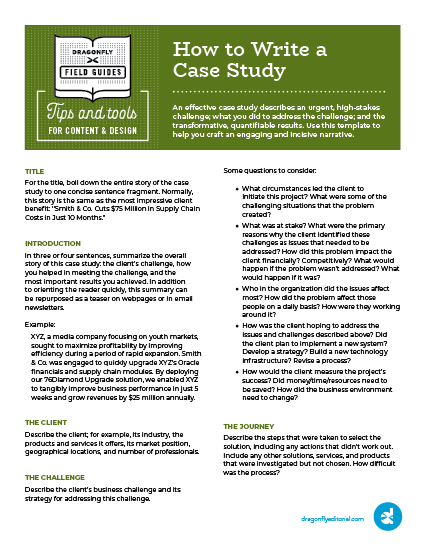A case study tells the story of a successful engagement in two to four pages—or even in a few sentences. The most effective case studies include three key elements: an urgent, high-stakes challenge; what you did to address the challenge; and the transformative, quantifiable results. Here’s a template you can use or adapt to create your own case studies.
TITLE
For the title, boil down the entire story of the case study to one concise sentence fragment. Normally, this story is the same as the most impressive client benefit: “Smith & Co. Cuts $75 Million in Supply Chain Costs in Just 10 Months.”
INTRODUCTION
In three or four sentences, summarize the overall story of this case study: the client’s challenge, how you helped in meeting the challenge, and the most important results you achieved. In addition to orienting the reader quickly, this summary can be repurposed as a teaser on webpages or in email newsletters.
Example:
XYZ, a media company focusing on youth markets, sought to maximize profitability by improving efficiency during a period of rapid expansion. Smith & Co. was engaged to quickly upgrade XYZ’s Oracle financials and supply chain modules. By deploying our 76Diamond Upgrade solution, we enabled XYZ to tangibly improve business performance in just 5 weeks and grow revenues by $25 million annually.
THE CLIENT
Describe the client; for example, its industry, the products and services it offers, its market position, geographical locations, and number of professionals.
THE CHALLENGE
Describe the client’s business challenge and its strategy for addressing this challenge.
Some questions to consider:
- What circumstances led the client to initiate this project? What were some of the challenging situations that the problem created?
- What was at stake? What were the primary reasons why the client identified these challenges as issues that needed to be addressed? How did this problem impact the client financially? Competitively? What would happen if the problem wasn’t addressed?What would happen if it was?
- Who in the organization did the issues affect most?How did the problem affect those people on a daily basis? How were they working around it?
- How was the client hoping to address the issues and challenges described above? Did the client plan to implement a new system? Develop a strategy? Build a new technology infrastructure? Revise a process?
- How would the client measure the project’s success?Did money/time/resources need to be saved? How did the business environment need to change?
THE JOURNEY
Describe the steps that were taken to select the solution, including any actions that didn’t work out. Include
any other solutions, services, and products that were investigated but not chosen. How difficult was the process?
THE DISCOVERY
Provide details about how the client found out about you and why the client chose you to perform this work. Include the key qualifications that functioned as differentiators. Did you help the client validate a sound business case before moving forward?
Some questions to consider:
- What were the reasons that the client engaged you (rather than employing one of your competitors or its own internal staff)?
- What qualities did the client believe you could bring to the effort that would help ensure its success?Did the client value your industry knowledge? Your solutions? Your experience in resolving similar issues? Your contacts in the industry?
THE SOLUTION
Summarize the work you performed during the engagement.
Some questions to consider:
- What steps/process did you follow to ensure that you resolved the client’s problem/delivered the requested solution?
- What were the components of the solution that you delivered? Did you develop a strategy, and stop there? Implement new technology? Provide change management support? Measure the results and drive continuous improvement?
- If you employed any unique skills or innovative problem-solving tactics during the engagement, what were they? How did you apply them?
- What did you do to minimize downtime and disruptions, accelerate implementation, and ensure change management? Mention any problems and how you resolved them.
- How did you wrap your solutions around your alliance’s partners products and services, if an alliance partner was involved?
THE RESULTS
Give the results achieved, quantifying if possible. Examples of results include cost take-out, streamlined business processes, seamless integration, faster time-to-market, improved margins, decreased risks, better market agility, improved bottom line, enhanced shareholder value, rapid return on investment, faster inventory turns, greater customer equity, enhanced supply chain visibility, 60% reduction in content management costs, and so forth.
Some questions to consider:
- What has changed for the client as a result of your work? How was the client’s situation improved as a result of this project? Did it improve the client’s competitive position?
- What measurable benefits did the solution provide?Did it reduce costs or reduce staff needs? If so, by exactly how much?
- What ROI did the client achieve? Provide the numbers if possible.
THE ONGOING SUPPORT
Describe any ongoing support and achievements.
THE CLIENT QUOTE
Ideally, customer quotes are embedded throughout your case study. But perhaps the strongest way to end a case study is with a positive quote from your customer, stating how the solution is helping them move their company forward.


